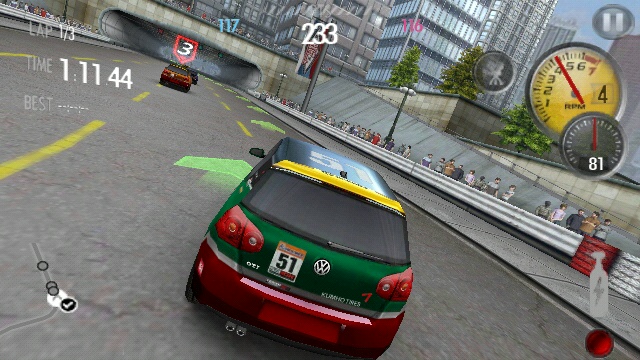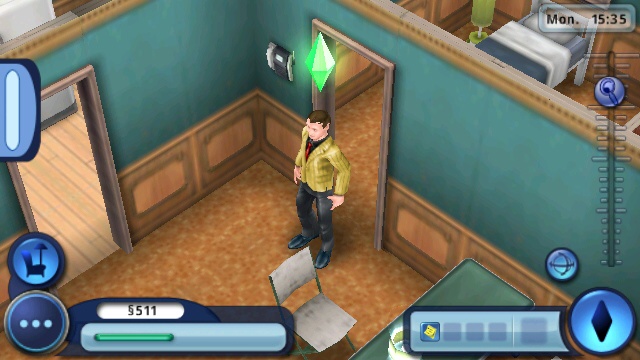In case you haven’t noticed, since my Nokia N8 review unit has arrived, I’ve been busy giving it a solid work out in terms of gaming. While games have always been popular on portable platforms, there’s been a resurgence in mobile gaming, in part down to processors and graphical technology catching up with the boxes in the corner of your living room. With capabilities that are in the same rough area as their larger cousins, ports and techniques can be replicated with far greater ease.
Now you could spend time criticising Nokia that they should have done something much sooner to make sure their top end phones could be ready for this explosion – but I’m not going to go there (much) in this article. Nokia have a pedigree in gaming in their past – while N-Gage might be misunderstood as something to laugh at, stop and think about titles like Pathway to Glory, Pocket Kingdom, Reset Generation and the N-Gage Snakes… Nokia knows games.



Snakes - the Nokia game where everything lined up and just worked.
So with the inclusion of a graphics co-processor in the Symbian^3 (now just Symbian) handsets, a large capacitive touch-screen, and an online delivery system in the Ovi Store, the current specs of the ecosystem are now lining up. You could argue that at a hardware level, there’s not that much between devices running the latest version of Android, iOS and Symbian.
That Nokia’s handsets, hardware and back-ends have evolved from the lessons and formats of the trailblazing N-Gage exercise will be lost on many that are keen to shout “copy!” as soon as possible.
Still, we are where we are now, and it’s a nice place to be in.
Let’s start with the two big issues in my mind – control and sound.
While the smartphone format of the moment remains the big touch screen, there are certain games that are going to suffer from the lack of physical controls – mostly the classic arcade style shoot-em-up games and the fighting genre. It’s unlikely we’ll see a really good version of Nokia’s “One” fighting game back on Symbian in the near future. And while the shoot-em-up games do their best to get around the issue (auto fire, smart interpretation of taps and slides on the screen, etc) they’ve never quite managed to find the perfect sweet spot on a handset. They’ve got close and I thank them for it, but that’s not been cracked yet.

Having new ways of interacting with the the game is a good thing. The driving game has been revitalised with the ability to steer a car from a steering wheel metaphor of the accelerometer to pick up the turns (and, to a certain extent, the acceleration, although most games have this set to be floored automatically). It’s now much more of an experience than having just left and right button presses. While this option has been available for some time on older handsets with accelerometer sensors with a handful of games, it's the addition of the processing power here that makes gaming come alive with the fine control and response you need. It's a lot harder to model a racetrack than a marble in a maze, and a lot nicer to control a car by steering using the phone itself than touching the left or right side of a screen in some weird button metaphor.
Just like the accelerometer, a touch screen has been available on previous Symbian handsets - but without the explosion of touch games that you would expect. Yes, it’s been added to puzzle and grid /Tetris like games but I’m still waiting on the rise of games with touch as the unique focus (such as the Flight Control / Line Drawing genre). Perhaps now all the touchscreens are capacitive we might see this in the future.
Who in Nokia decided to put the N8 and C7 speakers where they are? Given that most of the games are running in landscape mode, it means that when you have a stable grip on the handset, your left hand probably covers the speaker slot, killing any of the great sounds you might experience in the game. That’s a fail that’s made doubly worse because when you slap on some headphones, guess where the jack plug sits? Right in the crook of your left hand, diminishing your hold on your pricey smartphone. Hopefully this will be a better experience on other devices, but in terms of ergonomics, the N8 and C7 do lose a few points.
 Sharp turns, tilting graphics, engine revving... there's a lot going on in modern games.
Sharp turns, tilting graphics, engine revving... there's a lot going on in modern games.
With the return of a graphics chip to Symbian, the difference in what can be shown on the screen and thrown around, is huge. The 3D experience in the current crop of driving and action games shows that there is nothing fundamentally wrong with the Symbian platform and it can deliver as well as any other handset on the market.
Anecdotally, there are cases where the handling of games such as Need for Speed: Shift is slightly faster than on the iOS devices. No doubt some titles swing the other way, so to say all platforms are equal is probably the fairest result.
What will be interesting is if we get parity of game releases in, say, twelve months time. Building up the skills on a new platform and operating system takes time, and one of the reasons that the gaming titles released alongside the N8 are names that are familiar to gamers on other platforms is that some familiarity is required.
When you have a working game engine and design on platform A, when moving it to platform B you probably want to change as little as possible – and only work on the code changes to have it talk to the hardware correctly. That does make it sound a lot simpler than it actually is, but the rough gist is there.
 The Sims makes the jump, likely with the same graphical code as on iOS.
The Sims makes the jump, likely with the same graphical code as on iOS.
Once all the basics are worked out (and tested in practice on a number of release titles), I’d expect to see games completed at the same time for each of the three main platforms (plus Windows 7 and RIM, depending on the title – if Web OS returns, count that as well). Any decisions to have a platform be the first to get a week of exclusivity are going to be marketing and PR led, rather than being coding challenges.
And with a business hat on, you want to release the first title now so you can sell the sequel at a later date, catching up with the main releases for title three. Let's say you have three gaming titles, let's call them Pigeon, Super Pigeon and Pigeon God. You've just released Super Pigeon on the iPhone. So what do you release on Symbian? Pigeon. Because you want to maximise sales from that before you release Super Pigeon (and if you were to start with Super Pigeon, it's unlikely you'd make as many sales of Pigeon). The goal is to maximise the return on each title, on each platform.
So while youre waiting for Pigeon God to be ready across all the major platforms, you'll want to sell Super Pigeon in the period between Pigeon (on Symbian) and Pigeon God (cross platform) comes out. So there will be a number of titles that will have been out on other platforms, but given time, and sales, Symbian will be all caught up in a year or so. I suspect that's why Galaxy on Fire is out now, as Galaxy on Fire 2 is released for the iPhone. Symbian gets Galaxy on Fire 2 in the new year.
By the time the world is ready for Galaxy on Fire 3, I'd expect Symbian's release to be on the same day as Android and iOS.
 Galaxy on Fire on Symbian - catching up to the other platforms
Galaxy on Fire on Symbian - catching up to the other platforms
Is the N8, C7 or any of the upcoming Symbian handsets the perfect mobile gaming phone? No. Like any use of a smartphone there is an element of compromise in the design to ensure it can do other things. The touch screen taking over the space of any hardware buttons is obvious; the small battery to fit the form factor suddenly has to drive the CPU and GPU at full speed, constantly, and this hits the battery life; you still need to get the game onto the device – the Ovi Store helps but it’s still a weak link.
What is important is that the design decisions have now placed a large group of handsets in a similar specification chart. Irrespective of the operating system, this is a good thing for the industry and the gamer. It’s been this way since the home computer started, with the same game appearing on the Commodore 64, ZX Spectrum and Amstrad CPC home computers. Once you get similar machines in a big volume (be it the new Symbian family of devices, or the larger touchscreen-slabbed smartphones that America so loves) then the scale will win out and porting routes will be decided upon.
I’ve not been this excited about Symbian gaming since I got my hands on the Nokia QD and a N-Gage Arena log-in. Cutting edge handsets, acceptance by the industry, many more millions of handsets providing a huge addressable market, a thirst for gaming… all the building blocks are in place.
Now all Nokia and Symbian need to do is insert a credit to continue.
-- Ewan Spence, Nov 2010.
